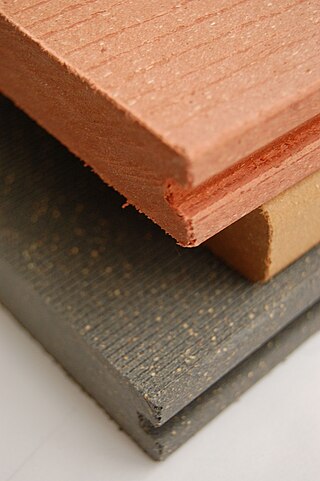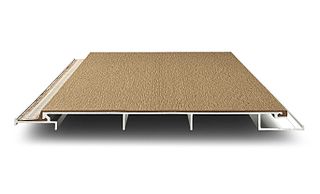
Reinforced concrete, also called ferroconcrete, is a composite material in which concrete's relatively low tensile strength and ductility are compensated for by the inclusion of reinforcement having higher tensile strength or ductility. The reinforcement is usually, though not necessarily, steel reinforcing bars and is usually embedded passively in the concrete before the concrete sets. However, post-tensioning is also employed as a technique to reinforce the concrete. In terms of volume used annually, it is one of the most common engineering materials. In corrosion engineering terms, when designed correctly, the alkalinity of the concrete protects the steel rebar from corrosion.

A composite material is a material which is produced from two or more constituent materials. These constituent materials have notably dissimilar chemical or physical properties and are merged to create a material with properties unlike the individual elements. Within the finished structure, the individual elements remain separate and distinct, distinguishing composites from mixtures and solid solutions. Composite materials with more than one distinct layer are called composite laminates.
Fiberglass or fibreglass is a common type of fiber-reinforced plastic using glass fiber. The fibers may be randomly arranged, flattened into a sheet called a chopped strand mat, or woven into glass cloth. The plastic matrix may be a thermoset polymer matrix—most often based on thermosetting polymers such as epoxy, polyester resin, or vinyl ester resin—or a thermoplastic.

The mechanical structure of an aircraft is known as the airframe. This structure is typically considered to include the fuselage, undercarriage, empennage and wings, and excludes the propulsion system.

A structural insulated panel, or structural insulating panel, (SIP), is a form of sandwich panel used as a building material in the construction industry.

Seismic retrofitting is the modification of existing structures to make them more resistant to seismic activity, ground motion, or soil failure due to earthquakes. With better understanding of seismic demand on structures and with recent experiences with large earthquakes near urban centers, the need of seismic retrofitting is well acknowledged. Prior to the introduction of modern seismic codes in the late 1960s for developed countries and late 1970s for many other parts of the world, many structures were designed without adequate detailing and reinforcement for seismic protection. In view of the imminent problem, various research work has been carried out. State-of-the-art technical guidelines for seismic assessment, retrofit and rehabilitation have been published around the world – such as the ASCE-SEI 41 and the New Zealand Society for Earthquake Engineering (NZSEE)'s guidelines. These codes must be regularly updated; the 1994 Northridge earthquake brought to light the brittleness of welded steel frames, for example.

Wood–plastic composites (WPCs) are composite materials made of wood fiber/wood flour and thermoplastic(s) such as polyethylene (PE), polypropylene (PP), polyvinyl chloride (PVC), or polylactic acid (PLA).

Syntactic foams are composite materials synthesized by filling a metal, polymer, cementitious or ceramic matrix with hollow spheres called microballoons or cenospheres or non-hollow spheres as aggregates. In this context, "syntactic" means "put together." The presence of hollow particles results in lower density, higher specific strength, lower coefficient of thermal expansion, and, in some cases, radar or sonar transparency.

In materials science, a metal foam is a material or structure consisting of a solid metal with gas-filled pores comprising a large portion of the volume. The pores can be sealed or interconnected. The defining characteristic of metal foams is a high porosity: typically only 5–25% of the volume is the base metal. The strength of the material is due to the square–cube law.

Isogrid is a type of partially hollowed-out structure formed usually from a single metal plate with integral triangular stiffening stringers. It was patented by McDonnell Douglas. Isogrids are extremely light and stiff. Compared to other materials, it is expensive to manufacture, and so it is restricted to spaceflight applications and some aerospace use.
Glass fiber reinforced concrete (GFRC) is a type of fiber-reinforced concrete. The product is also known as glassfibre reinforced concrete or GRC in British English. Glass fiber concretes are mainly used in exterior building façade panels and as architectural precast concrete. Somewhat similar materials are fiber cement siding and cement boards.

Honeycomb structures are natural or man-made structures that have the geometry of a honeycomb to allow the minimization of the amount of used material to reach minimal weight and minimal material cost. The geometry of honeycomb structures can vary widely but the common feature of all such structures is an array of hollow cells formed between thin vertical walls. The cells are often columnar and hexagonal in shape. A honeycomb-shaped structure provides a material with minimal density and relative high out-of-plane compression properties and out-of-plane shear properties.

A sandwich panel is any structure made of three layers: a low-density core, and a thin skin-layer bonded to each side. Sandwich panels are used in applications where a combination of high structural rigidity and low weight is required.

Sandwich theory describes the behaviour of a beam, plate, or shell which consists of three layers—two facesheets and one core. The most commonly used sandwich theory is linear and is an extension of first-order beam theory. The linear sandwich theory is of importance for the design and analysis of sandwich panels, which are of use in building construction, vehicle construction, airplane construction and refrigeration engineering.
Plascore Incorporated manufactures honeycomb core, cleanrooms, and composite panels marketed under the brand Plascore. Honeycomb is used in aerospace, marine, military, safety, transportation, and other applications. When honeycomb is sandwiched between two surfaces, it effectively creates a distance between the two surfaces more or less like an I-beam. The resulting composite structure exhibits a high strength-to-weight ratio and shear strength. Shear strength is the measured ability of a material to resist structural failure. Plascore honeycomb is designed to increase shear strength while adding minimal additional weight. Plascore is a global organization, with a 185,000 sq. ft. headquarters and three additional manufacturing facilities in Zeeland, Michigan. Those three facilities are 50,000, 40,000 and 80,000 sq. ft. in size. The company also has an 85,000 sq. ft. manufacturing plant in Waldlaubersheim, Germany; and sales offices throughout the world. Plascore is AS/EN/JISQ9100, ISO 14001:2004, and ISO 9001:2008 Certified, and the company's PP Honeycomb has received a Lloyds Register Certificate of Approval of a Core Material. Plascore is also AS9100 certified, an industry standard required by the majority of major aircraft manufacturers that provides verification of consistent aerospace product quality.

Aluminium foam sandwich (AFS) is a sandwich panel product which is made of two metallic dense face sheets and a metal foam core made of an aluminium alloy. AFS is an engineering structural material owing to its stiffness-to-mass ratio and energy absorption capacity ideal for application such as the shell of a high-speed train.
This glossary of structural engineering terms pertains specifically to structural engineering and its sub-disciplines. Please see Glossary of engineering for a broad overview of the major concepts of engineering.

Hybrid wood or wood hybrid systems (WHS) is a multilayer composite material, composed on the surface of a skin made of composite wood (WPC) adhering to an underneath structural core, in general aluminum. Invented in Japan in 2008, this technological evolution is based on wood composite technology which was conceived in 1972 by Sadao Nishibori and patented in 1983 to substitute threatened exotic wood species. WHS are not fibre-reinforced plastic (FRP).
Titanium foams exhibit high specific strength, high energy absorption, excellent corrosion resistance and biocompatibility. These materials are ideally suited for applications within the aerospace industry. An inherent resistance to corrosion allows the foam to be a desirable candidate for various filtering applications. Further, titanium's physiological inertness makes its porous form a promising candidate for biomedical implantation devices. The largest advantage in fabricating titanium foams is that the mechanical and functional properties can be adjusted through manufacturing manipulations that vary porosity and cell morphology. The high appeal of titanium foams is directly correlated to a multi-industry demand for advancement in this technology.
















